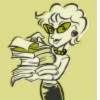
Bradbury, Judy. 2003. CHILDREN’S BOOK CORNER: A READ-ALOUD RESOURCE WITH TIPS, TECHNIQUES, AND PLANS FOR TEACHERS, LIBRARIANS AND PARENTS LEVEL PRE-K-K. Westport, CT: Libraries Unlimited. ISBN 1-59158-048-X
Judy Bradbury has to her credit a set of handbooks geared toward helping teachers, librarians, and parents in their quest for great read-alouds. This series covers Pre-K through the sixth grade. For the purpose of this review, the Pre-K - Kindergarten volume is referenced. CHILDREN’S BOOK CORNER includes lesson plans for fifty-three different picture books with copyrights ranging from 1942 to 2002. Also included are “pull-out pages” for parents. These pages include tips for parents as well as lists of additional theme-related, age-appropriate trade books. These lists are organized not only by subject, but also by type of book. This includes wordless, poetry and teacher resource books.
This book’s strongest asset is the sheer number of read-aloud lesson plans included. With fifty-three stories, one could read a story per week for a whole year! These lesson plans use classic titles such as GREEN EGGS AND HAM by Dr. Seuss. Bradbury also includes more contemporary books, including Amy Hest’s KISS GOODNIGHT. These lesson plans include critical pieces of information: knowing how long a story takes to read; pre-reading activities used to access children’s prior knowledge; techniques to use while reading the story; follow-up discussion questions and activities; and paired titles (“another book about…is…”). Beyond these thoughtful lesson plans, the author provides a brief description of the elements of a good picture book. In addition, children’s book awards and book review resources, such as
The Horn Book Magazine, www.ala.org, and Jim Trelease’s THE NEW READ-ALOUD HANDBOOK, are listed.
Though a useful resource, CHILDREN’S BOOK CORNER has its weaknesses. For example, the copyright on many of the picture books referenced are old—some as old as 1942 (THE RUNAWAY BUNNY by Margaret Brown). While the majority of the books are not 66 years old, most titles are pre-1990. Another of the weaknesses has to do with the photographs included in this resource. Often, there is an unclear connection between the read-aloud plans and the adjacent photos. In one instance, the photographs show an adult and child reading ROSIE’S WALK. However, the photographs are adjacent to the read-aloud plans for BOOTSIE BARKER BITES. The lesson plan for ROSIE’S WALK is later in the book. Perhaps it is because the publisher did not acquire permission to print the covers of these books, necessitating the use of other types of photographs. In my opinion, this particular weakness provokes an amateurish impression. It’s as though the publisher was too lazy to procure permission to use the front covers for the rest of the titles.
Other weak points in this book are not what it includes, rather what it excludes. CHILREN’S BOOK CORNER lacks consistent and complete bibliographic information among the read-aloud titles. Bradbury includes the title, author, illustrator and publisher for each title. Yet, most titles lack the copyright date and none have ISBNs. Other omissions include consistent incorporation of front cover pictures, paired book suggestions, and the books’ classification, i.e. whether a book is Easy or Nonfiction. While the call number might be considered superfluous or an unrealistic expectation, knowing the type of book would be helpful in terms of searching for it. For example, it is unclear if I LOVE TRAINS! is found in the Easy or Nonfiction section of a library or bookstore.
Bradbury is careful to include a complete citation for each book for which a front cover picture is shown. The acquisition of publisher permission is made clear by the consistent use of the phrase “used with permission.” A formal citation for each read-aloud book, however, is not provided. The bibliographic information which is provided is in a table preceding each lesson plan. There is no formal bibliography anywhere in the resource.
The informal, conversational voice makes CHILDREN’S BOOK CORNER easy to read and understand. The book is broken into manageable sections which are delineated by intended audience: teachers and librarians, parents or both. Non-professional educators need not worry about the use of technical terminology nor confusing educational strategies. The teacher/librarian and parent sections contain duplicate information, each with an audience-specific tone. Bold headings facilitate the location of specific information. Another helpful access feature is the inclusion of four different indices. Readers can search by subject, title, author, and illustrator. Bradbury also provides an appendix of “…books too good to miss (but-wouldn’t-fit-in-the-main-section).” These titles are arranged by topic.
This resource speaks to a wide audience—virtually anyone who works with young children. All teachers who work with preschool through kindergarten-aged children would benefit from the information in this book. For librarians who have Easy collections in their libraries, this is an essential title. Finally, parents, grandparents, babysitters—in effect any caregiver of young children—could use these lesson plans to make story time a richer learning experience.
This resource is highly recommended for teachers, librarians, caregivers and parents of children ages 2-6.
 Arnosky, Jim. 2008. THE BROOK BOOK: EXPLORING THE SMALLEST STREAMS. Westport, CT: Dutton Children’s Books. ISBN 9-780525-477167
Arnosky, Jim. 2008. THE BROOK BOOK: EXPLORING THE SMALLEST STREAMS. Westport, CT: Dutton Children’s Books. ISBN 9-780525-477167
